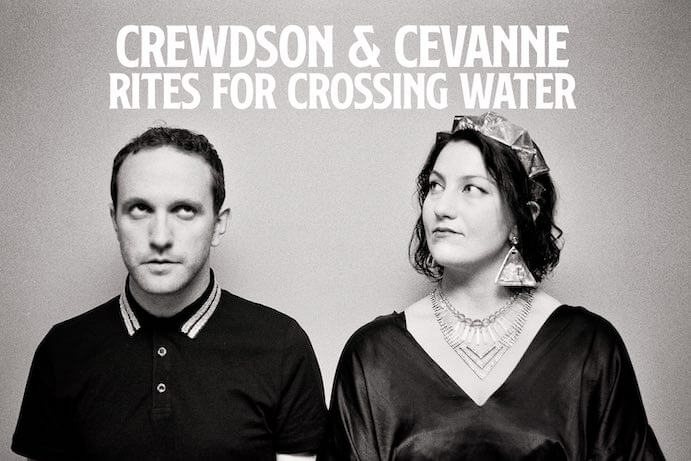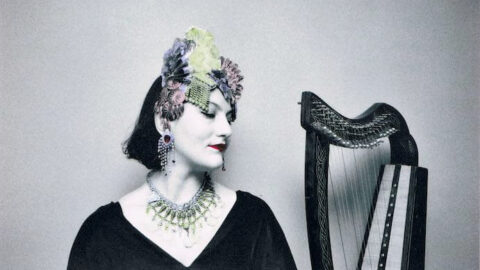The music of Anglo-Armenian composer, performer, and multi-media artist Cevanne Horrocks-Hopayian breaks through genre barriers with impunity: blues vocals, a rhythm section, and jazz saxophone might cohabit with a classical chamber ensemble, a traditional Armenian mode with contemporary musical language, or acoustic instruments with recorded found sounds. A performer herself, she is active as a singer, harpist, and live electronics artist, working with classical musicians and as half of the folk electronica duo Crewdson & Cevanne. During the Covid-19 pandemic, Horrocks-Hopayian explored other forms of creativity, as a visual artist and writer as well as composer and collaborative performer. She recently released her first album as a solo composer, Welcome Party (NMC Recordings, 2022) featuring members of the London Symphony Orchestra. I Care If You Listen asked Cevanne about her latest projects.
Your music has such a strong sense of place. How has your background had an impact on your music?
My music emerges from the different environments I inhabit while I work: conversations and collaborations in my community, references to local stories, industries, and species are all woven into its fabric. A changing sense of place often generates creativity in me. I’m the result of migration. Although I grew up in Suffolk, neither of my parents (English and Armenian) are from there. With this in mind, it’s probably no coincidence that I feel my ideas take flight, in the best sense, when responding to places and people, to travel and even refuge — the stuff of life and folklore. I often make music out of field recordings as a way of documenting and communicating with my surroundings. With Crewdson, I form these samples into modern folk songs.

Many of the pieces on your album Welcome Party were inspired by the extraordinary London house at 575 Wandsworth Road designed by Khadambi Asalache. Tell us about your connection to the house.
My relationship with 575 Wandsworth Road owes everything to Susie Thomson, a basket weaver who established a residency there with the London Symphony Orchestra. Her partner, Khadambi Asalache, had filled the house with his striking art — fretwork carvings across the walls and ceilings, and murals on the wooden floors. He left it to the National Trust, and Susie imagined a way for it to continue to generate new art, specifically sonic art. I was their first composer-in-residence, and over the course of 2021 I refined the music I developed in the house into an album, titled Welcome Party, with NMC Recordings. My thoughts on travel and place – real and imagined – merged recordings of the house itself with exquisite performances by the LSO, saxophonist Trish Clowes, drummer Tim Giles, singer Ziazan, and the Choir of Girton College, Cambridge.
I loved Cap o’Rushes, the piece you composed during lockdown for diverse ensembles. How did this project come about and what specific challenges did you need to address?
Thank you! For many years I’ve wanted to set the Suffolk folktale Cap O’Rushes for dance and for some of my favourite musicians. And what better time to embark on an international cross-art collaboration than during a pandemic? I’m being flippant, of course… But I love how collaboration brings new perspectives to stories you thought you knew by heart. The original tale Cap O’Rushes shares similarities with Shakespeare’s King Lear, with the Suffolk version following the heroine’s journey to a much less tragic end. Developing my retelling with Suffolk filmmakers and choreographers was refreshing and a way of reconnecting with the place during such an isolated time.
As you can imagine, it was a challenge working within extreme uncertainty. But as our film was created to open the International Conference for Arts, Health and Wellbeing, we made it our priority to consider our personal wellbeing as much as possible. I’ve been writing for Clarence Adoo, one of the featured musicians, for some years now, so this film marked a development in our shared use of electronic instruments. Following a car accident and resulting paralysis, Clarence has pioneered a new HeadSpace instrument which has inspired many composers and performers.
You and Crewdson just released a new EP, Rites for Crossing Water, in April 2022. Tell us about the collaboration and your amazing sonic bonnet!
Like Clarence’s HeadSpace, the Sonic Bonnet is a midi-controller. It is inspired by Armenian headdress, amongst other things, and is made in collaboration with milliner Jodie Cartman and instrument builder Hugh Jones (Crewdson). The metal jewelry is conductive, and there’s an accelerometer, so when I move my head or tap the metal I can manipulate my live vocals or trigger beats that I’ve made on Ableton.
Crewdson and I have created the Rites For Crossing Water EP as part of an audio-visual installation projected and reflected in the Coventry canal, commissioned for Random String Festival. We make modern folk songs by layering and looping ‘found sounds’ of specific geographies. On the title track, we transformed our field recordings of the mooring posts along the towpath into sparkling tuned percussion. In Coventry, for the first time and in collaboration with animator Jessica Glover and Ludic Rooms, we’ve expanded our production into multi-media, including projection-mapped billboards and a book.

Rites For Crossing Water came about when our festival commissioners encouraged us to imagine the traditions of ‘future folk.’ In response, we created 19 short texts as new rituals for crossing water (referring to the 19 bridges on the way to the end of the Coventry canal). After all, who knows what future generations will make of mysterious instructions such as “DON’T TOUCH YOUR FACE”?
You can read the rites as a visual poem in our book and you can hear the lyrics on the EP. On the title track of the EP, Rites for Crossing Water, the rituals are recounted as lessons — taught to ensure safe arrival via water. The Sailing Song is written from the perspective of the one giving the guidance. It reflects folktales in which the heroine is helped by charmed gifts bestowed on her by benevolent creatures. At its core is the desire to protect those we love from the dangers of the shadows by the waters. Meanwhile, the Drinking Song draws us into safe harbour, reuniting listeners with friends after a long time apart. For this song, Crewdson built a new instrument to provide the celebratory beat: a robotic pint of beer!
There’s a very strong visual dimension to your work. How do you see this developing in future projects?
Your questions catch me at a moment when I’m brimming with ideas for new visual pieces, which is a wonderful feeling. It’s thanks to being in residence at the Mahler & LeWitt Studios in the original workspaces of Anna Mahler and Sol LeWitt in Italy this last month. I have created ‘eye music’ scores for many years, extending from Renaissance traditions to create formal, physical, and sometimes tactile limitations for myself to compose within. These range from apertures in the paper, to suturing. There are some examples on the Welcome Party album, where I carve fretwork manuscripts in response to the artwork of 575 Wandsworth Road. And the new track, Widdershins, a vocal round for the Coventry ring road which ends the Rites For Crossing Water EP, is notated anti-clockwise in a circle which punctuates my line drawing map of the Coventry Canal.
However, my recent experiments have pushed me further into conceptual approaches, and I feel liberated. Over the lockdown, I gradually managed to regain my creativity by exploring the possibilities of instructional texts. Without music notation, or recording, I cut straight to ideas which could be performed, or imagined – some open, others specific. It was poignant to make plans for a piece at a time so uncertain that they might not be realised, although sometimes they detailed the most day-to-day rituals. Their early forms inspired the texts in Rites For Crossing Water and Cap O’Rushes. My next stage is to explore forms of notation as instruction to produce the visual works I’ve always hoped to see.
You can imagine why I’m thrilled to be around Sol LeWitt’s early wall texts in Spoleto! Back at home, I am most encouraged by creatives who play across art forms, the polymaths. Khadambi Asalache was one, Crewdson another, and so is Emily Juniper – a printer and playwright, and new collaborator of mine who designed my Welcome Party artwork. I am looking forward to sharing my new ideas, with them, and with you all, and finding myself responding to new places again.
I CARE IF YOU LISTEN is an editorially-independent program of the American Composers Forum, funded with generous donor and institutional support. Opinions expressed are solely those of the author and may not represent the views of ICIYL or ACF.
A gift to ACF helps support the work of ICIYL. For more on ACF, visit the “At ACF” section or composersforum.org.
























